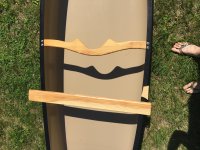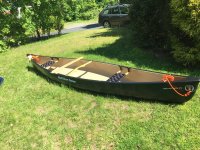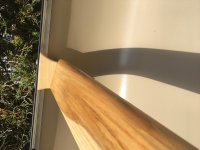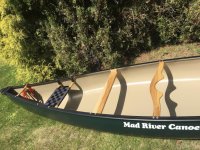I've received my kneeling thwart from Ed's Canoe. There are no instructions included and thought this group would have some good advice.
My canoe is a short tandem (Refection 15) in Royalex. There are two handles by the stern and bow, two seats and a yoke. No other thwarts. I've paddled it backwards sitting in the bow seat and that was OK but I wasn't trimmed very well and heading back upstream wasn't great. I'm planning to install the kneeling thwart between the stern seat and the center yoke.
Where is the optimal place to install it?
I've heard 18" behind the center but this canoe is only 15'4".
Also, the drops included are pre-angled which is nice but I guess that means that wherever the thwart ends up hanging from the gunnels is the height and angle it will be. Hopefully it will be correct for me and feel OK.
Lastly, do I need to trim the excess wood at either end of the kneeling thwart at any sort of angle to match the curve of the canoe or is a right angle cut fine?
Thanks in advance
My canoe is a short tandem (Refection 15) in Royalex. There are two handles by the stern and bow, two seats and a yoke. No other thwarts. I've paddled it backwards sitting in the bow seat and that was OK but I wasn't trimmed very well and heading back upstream wasn't great. I'm planning to install the kneeling thwart between the stern seat and the center yoke.
Where is the optimal place to install it?
I've heard 18" behind the center but this canoe is only 15'4".
Also, the drops included are pre-angled which is nice but I guess that means that wherever the thwart ends up hanging from the gunnels is the height and angle it will be. Hopefully it will be correct for me and feel OK.
Lastly, do I need to trim the excess wood at either end of the kneeling thwart at any sort of angle to match the curve of the canoe or is a right angle cut fine?
Thanks in advance




